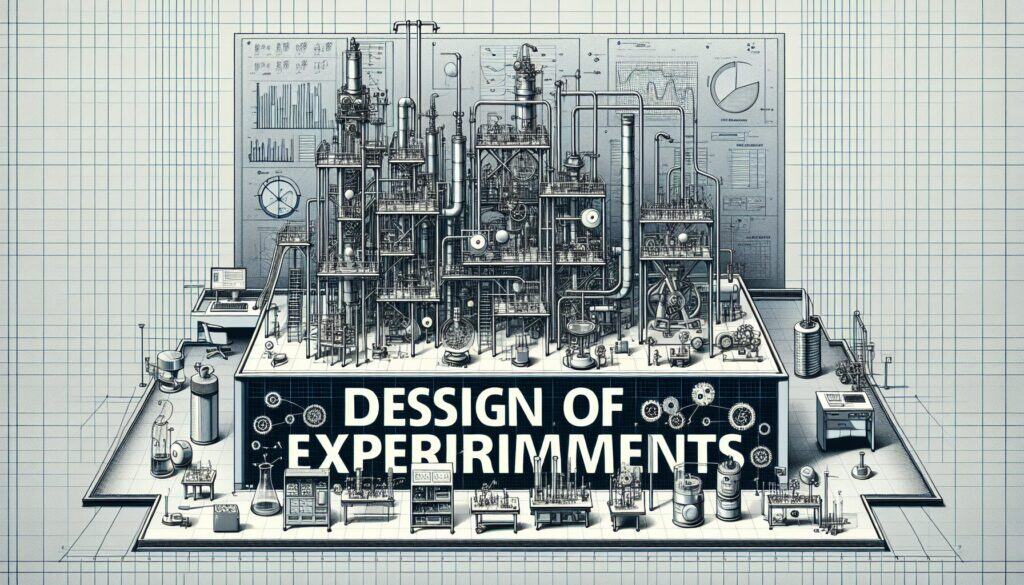Metodología estadística sistemática para determinar la relación entre los factores que afectan a un proceso o producto y la producción de dicho proceso o producto, realizando cambios planificados en las variables de entrada y observando los efectos en las variables de salida.
- Metodologías: Ingeniería, Calidad
Diseño de experimentos (DOE)

Diseño de experimentos (DOE)
- Análisis de varianza (ANOVA), Mejora continua, Diseño para Seis Sigma (DfSS), Optimización del diseño, Mejora de procesos, Control de calidad, Gestión de calidad, Análisis estadístico
Objetivo:
Cómo se utiliza:
- Consiste en planificar un experimento en el que múltiples factores de entrada (variables) se modifican intencionadamente de forma estructurada para observar sus efectos individuales e interactivos sobre un resultado (respuesta). A continuación, se utiliza el análisis estadístico para identificar los factores significativos y los ajustes óptimos.
Ventajas
- Permite estudiar múltiples factores simultáneamente, lo que la hace eficiente; Puede identificar interacciones entre factores; Ayuda a optimizar procesos y diseños de productos para obtener los resultados deseados; Proporciona conclusiones estadísticamente válidas.
Contras
- Su diseño y análisis pueden ser complejos, y a menudo requieren programas informáticos estadísticos y conocimientos especializados; pueden requerir un número significativo de ejecuciones experimentales, que pueden ser costosas o requerir mucho tiempo; presuponen que se han identificado todos los factores importantes.
Categorías:
- Ingeniería, Lean Sigma, Fabricación, Resolución de problemas, Diseño de producto, Calidad
Ideal para:
- Investigar sistemáticamente los efectos de múltiples variables en un proceso o producto para optimizar el rendimiento, resolver problemas o mejorar los diseños.
La metodología del Diseño de Experimentos (DOE) se aplica con frecuencia en industrias como la farmacéutica, la manufacturera y la agrícola, donde la optimización de los procesos es fundamental para el éxito. En el sector farmacéutico, el DOE puede emplearse en estudios de formulación para comprender cómo afectan las variaciones en las concentraciones de los ingredientes a la eficacia y estabilidad de los fármacos, acelerando así los ciclos de desarrollo. En la industria manufacturera, las organizaciones utilizan el DOE durante la fase de diseño del producto para evaluar cómo afectan los cambios en los ajustes de la máquina a la calidad del producto, orientando las mejoras que reducen los residuos y las repeticiones. Los científicos agrícolas aplican la EOD para evaluar cómo factores como el tipo de suelo, el agua y las condiciones de los fertilizantes influyen en el rendimiento de los cultivos, proporcionando datos fundamentales para mejorar las prácticas agrícolas. Esta metodología es especialmente beneficiosa en contextos de investigación y desarrollo, donde equipos formados por ingenieros, científicos y jefes de producto se reúnen para diseñar experimentos que analizan múltiples variables simultáneamente, revelando interacciones intrincadas que los estudios de una sola variable podrían pasar por alto. Requiere un enfoque estructurado de la planificación y la ejecución, que exige la colaboración entre las partes interesadas para determinar qué factores investigar, garantizando que el experimento se ajuste a los objetivos del proyecto. El análisis estadístico posterior a la fase experimental permite a los equipos interpretar los resultados con confianza, lo que conduce a decisiones bien fundadas que optimizan el rendimiento del producto o la eficiencia del proceso basándose en pruebas sólidas y no en experiencias anecdóticas. Mediante una planificación cuidadosa, la EOD destaca como una poderosa herramienta para la investigación sistemática, ofreciendo un camino claro para la innovación y la mejora en diversos sectores.
Pasos clave de esta metodología
- Identifique los objetivos y las variables de respuesta del experimento.
- Seleccione los factores de entrada y sus niveles a investigar.
- Elegir el diseño experimental adecuado (por ejemplo, factorial completo, factorial fraccionado, método de superficie de respuesta).
- Aleatorizar el orden de ejecución para minimizar el sesgo.
- Realice los experimentos según el diseño.
- Analizar los datos utilizando métodos estadísticos (por ejemplo, ANOVA).
- Interpretar los resultados para identificar factores e interacciones significativos.
- Optimice los ajustes para lograr los resultados deseados.
Consejos profesionales
- Utilice diseños factoriales fraccionados cuando se trate de un gran número de variables para reducir el número total de experimentos sin dejar de obtener información útil sobre los efectos principales y las interacciones.
- Incorporar la aleatorización en las ejecuciones experimentales para minimizar el sesgo y mejorar la validez de los resultados eliminando los errores sistemáticos debidos a factores no controlados.
- Analizar los residuos del modelo para comprobar la varianza no constante y los valores atípicos, asegurándose de que los supuestos de la pruebas estadísticas para obtener conclusiones fiables.
Leer y comparar varias metodologías, recomendamos el
> Amplio repositorio de metodologías <
junto con otras más de 400 metodologías.
Sus comentarios sobre esta metodología o información adicional son bienvenidos en la dirección sección de comentarios ↓ , así como cualquier idea o enlace relacionado con la ingeniería.
Contexto histórico
1949
1950
1950
1960
1960
1960
1960
1940
1950
1950
1958
1960
1960
1960
1960
(si se desconoce la fecha o no es relevante, por ejemplo "mecánica de fluidos", se ofrece una estimación redondeada de su notable aparición)















Publicaciones relacionadas
Simulación de Monte Carlo
Pruebas basadas en modelos
Comprobación de modelos
Investigación con métodos mixtos
A prueba de errores (Poka-Yoke)
Pruebas del perfil de la misión